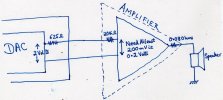IndianEars
Well-Known Member
As an over view, If you consider the Pre-Amp as a Box receiving an input signal from a CD Player or DAC etc, the Volume Control on a Pre Amp increases or decreases the signal at the output of the Pre amp.@IndianEars
Also, if you don't mind my asking, what does the volume control on the pre-amp do ? Increase the voltage ? If so, is the 2 volts at a lower volume position and the 70 volts at it's highest point ? Which is better, keeping the preamp volume higher or amplifier gain higher ? Thanks.
The Preamp has a specified Max Gain (usually a Max Gain of 400% to 1000%). This is the Gain available from the unit with its Volume control turned to Max.
Let us take some practical examples and Signal levels:
OUTPUT FROM A CD PLAYER
Music sources such as a CD Player or DAC typically provide a Max signal of 1 Volt or 2 Volts. Let us consider a CD Player Specified with with a 1 Volt output.
The CD Player will provide this 1 Volt Output only when the CD has a signal recorded on it at Full Output. Recording Engineers will almost Never record a Full Signal on a CD Player because if the music goes even slightly louder after that, there will be Gross distortion in the recording.
Hence, during typical music played on a CD, the Output Signal from the CD player will probably be around 0.2 Volts to 0.5 Volts.
The Pre amp receives this 0.2 V to 0.5 Volts.
The Volume Control on the Pre amp enables the User to adjust the Sound Level from the speakers to his liking.
Sometimes, the listener may not want any sound at all (eg when he gets a phone call) and will want to turn the Volume to Zero, ie No Output Signal from the Pre amp. The Pre amp then Reduces / Cuts the signal to the extent required.
At the other extreme, the user may want very loud music for a party. The Volume Control on the Pre amp will then increase the incoming signal ( Provide GAIN) as required.
Hence the Pre amp may receive a signal of 0.2 Volts and the Volume control will decrease or increase this signal (as required by the user) from 0 Volts to approx 1 Volt)
The Pre amp Volume Control ATTENUATES (Decrease) or AMPLIFIES (Increase) the incoming Signal.
Usually, at mid position of the Volume control, the Pre amp Output signal level is the same as the input signal level, and is said you be its "UNITY GAIN POSITION."
Does this answer your query ? Or did I not understand it correctly ?


